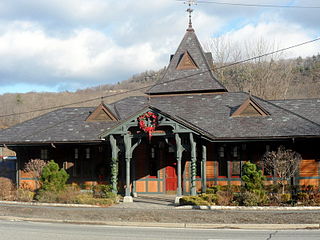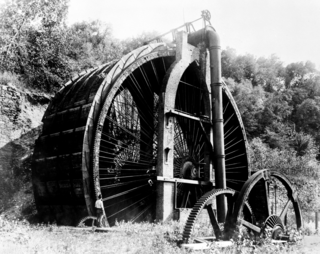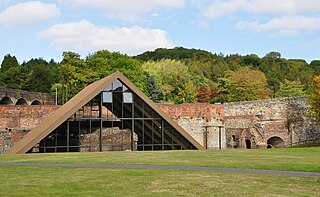
Tuxedo is a town located in Orange County, New York along the Ramapo River. As of the 2010 census, the town had a total population of 3,624. The town is in the southeastern part of the county in the Ramapo Mountains. New York State Route 17 and the New York State Thruway pass through the town. The name is derived from a Lenape word tucseto, which has several known meanings.

The Burden Iron Works was an iron works and industrial complex on the Hudson River and Wynantskill Creek in Troy, New York. It once housed the Burden Water Wheel, the most powerful vertical water wheel in history. It is widely believed that George Washington Gale Ferris Jr., inventor of the Ferris wheel, had occasion to observe the wheel while a student at Rensselaer Polytechnic Institute. The iron works site was listed on the National Register of Historic Places as an archaeological site in 1977. The Burden Ironworks Office Building was previously listed in 1972.

Coalbrookdale is a village in the Ironbridge Gorge in Shropshire, England, containing a settlement of great significance in the history of iron ore smelting. It lies within the civil parish called the Gorge.

Henry Cort was an English ironmaster. During the Industrial Revolution in England, Cort began refining iron from pig iron to wrought iron using innovative production systems. In 1783-1784 he patented an improved version of the puddling process for refining cast iron although its commercial viability was only accomplished by innovations introduced by the Merthyr Tydfil ironmasters Crawshay and Homfray.

An ironworks or iron works is a building or site where iron is smelted and where heavy iron and steel products are made. The term is both singular and plural, i.e. the singular of ironworks is ironworks.
Robert Parker Parrott was an American soldier and inventor of military ordnance.

Greenwood Furnace State Park is a 423-acre (171 ha) Pennsylvania state park in Jackson Township, Huntingdon County, Pennsylvania in the United States. The park is near the historic iron making center of Greenwood Furnace. The park includes the ghost town of Greenwood that grew up around the ironworks, old roads and charcoal hearths. Greenwood Furnace State Park is adjacent to Rothrock State Forest and on the western edge of an area of Central Pennsylvania known as the Seven Mountains. The park is on Pennsylvania Route 305, 20 miles (32 km) south of State College.

The West Point Foundry was a major American ironworking and machine shop site in Cold Spring, New York, operating from 1818 to about 1911. Initiated after the War of 1812, it became most famous for its production of Parrott rifle artillery and other munitions during the Civil War, although it also manufactured a variety of iron products for civilian use. The increase of steel making and decreasing demand for cast iron after the Civil War caused it to become bankrupt gradually and cease operations during the early 20th Century.

The Lehigh Crane Iron Company was a major ironmaking firm in the Lehigh Valley from its founding in 1839 until its sale in 1899. It was founded under the patronage of Josiah White and Erskine Hazard, and financed by their Lehigh Coal & Navigation Company, which hoped to promote the then-novel technique of smelting iron ore with anthracite coal. This was an important cost and energy savings technique, since either an expensive charcoaling nor coke producing process and transport costs was totally eliminated so produced a great acceleration in the underpinnings of the American industrial revolution.

Gouverneur Kemble was a two-term United States Congressman, diplomat and industrialist. He helped found the West Point Foundry, a major producer of artillery during the American Civil War.

James Peter Allaire was a noted master mechanic and steam engine builder, and founder of the Allaire Iron Works, the first marine steam engine company in New York City, and later Howell Works, in Wall Township, New Jersey. His credits also include building both the first compound steam engine for marine use and the first New York City tenement structure.

Onota was a village in the Upper Peninsula of the U.S. state of Michigan. It was located on the Grand Island Bay of Lake Superior near the present-day community of Christmas about five miles (8 km) west of Munising in Alger County. The site of Onota is within the Bay Furnace Campground and Picnic Area of the Hiawatha National Forest. The remains of Bay Furnace, a blast furnace used for smelting iron, is the only extant remnant of the town. Bay Furnace was listed on the National Register of Historic Places and designated a Michigan State Historic Site in 1971.
The Georges Creek Coal and Iron Company is a defunct coal mining, iron producer and railroad company that operated in Maryland from 1835 to 1863.

Old Iron Town, originally Iron City, is a ghost town in Iron County, Utah, United States. It is located in Dixie National Forest, about 22 miles (35 km) from Cedar City. The settlement was founded in 1868 as a second attempt to mine iron from Iron Mountain after a disappointing yield from Cedar City. The colony lasted until 1876, when strife from the Edmunds–Tucker Act and the Panic of 1873 forced its closure. The site was added to the National Register of Historic Places in 1971.

The Southfield Furnace Ruin in Southfields, New York, was a longtime smelting site for iron ore mined from nearby veins in what is now Sterling Forest State Park. It is located on the north side of Orange County Route 19, 0.7 miles northwest of the junction with New York State Route 17.

The Société des aciéries de Longwy was a steelworks located in Longwy, Meurthe-et-Moselle, France.
Lal Lal Iron Mine and Smelting Works were located close to the western branch of the Moorabool River, near the town of Lal Lal, Victoria, Australia, which lies on the Geelong-Ballarat railway line about 19 km from Ballarat. From 1875 to 1884, pig iron was made there in a blast furnace using iron ore mined at the site, locally produced charcoal, and limestone from a nearby deposit. The works ultimately proved to be uneconomic. It remains the only attempt to establish an iron smelting industry in Victoria.
The Bogolong iron mine and blast furnace is an abandoned iron mining and smelting site, near Bookham, New South Wales, Australia. Located in an area known best for sheep grazing and wool, it has been called Australia’s ‘forgotten furnace'.



















